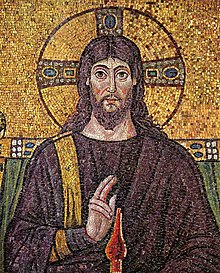Jésù
Ìrísí
| Jésù ará Násárẹ́tì | |
|---|---|
 6th-century mosaic of Jesus at Basilica of Sant'Apollinare Nuovo in Ravenna. Though depictions of Jesus are culturally important, no undisputed record of what Jesus looked like is known to exist. | |
| Ọjọ́ìbí | c. 4 BC/BCE[1] Bethlehem, Judea, Ilẹ̀ọbalúayé Rómù (traditional); Nazareth, Galilee (historical Jesus)[2] |
| Aláìsí | c. 30 AD/CE[1] Calvary, Judea, Ilẹ̀ọbalúayé Rómù (According to the New Testament, he rose on the third day after his death.) |
| Cause of death | Crucifixion (Historically trusted, important meaning in Christian belief) No cause/death disputed (Islamic belief) |
| Resting place | Traditionally and temporarily, a garden tomb located in what is now the Church of the Holy Sepulchre, Jerúsálẹ́mù.[3] |
Jésù ará Násárẹ́tì (c. 5 BC/BCE – c. 30 AD/CE[1]), tàbí Jésù Kírísítì tabi Jésù, jẹ́ ẹni tó ṣe kókó jùlọ, yàtọ̀ sí Ọlọ́run nínú Ẹ̀sìn Kírísítì, tí àwọn ẹlẹ́sìn náà gbà gẹ́gẹ́ bí Olùgbàlà Aráyé, èyí tí ó jẹ́ àsọtẹ́lẹ̀ ni Májẹ̀mú Láéláé nínú Bíbélì, tí gbogbo àwọn ẹlẹ́ṣin Kíristi tàbí irú wọn gbà pé òun ni Ọmọ Ọlọ́run àti àwòrán Ọlọ́run tí ó jí dìde nínú ipò òkú.[4] Islamu gba Jesu gege bi woli ati Messiah.[5] Ọ̀pọ̀ àwọn ẹ̀sìn mìíràn ni wọ́n tún tẹrí ba fún un lóríṣi ọ̀nà. Jésù jẹ́ ẹnìkan tó ṣe pàtàkì nínú ìtàn ọmọ ènìyàn.

|
Àyọkà yìí tàbí apá rẹ̀ únfẹ́ àtúnṣe sí. Ẹ le fẹ̀ jù báyìí lọ tàbí kí ẹ ṣàtúnṣe rẹ̀ lọ́nà tí yíò mu kúnrẹ́rẹ́. Ẹ ran Wikipedia lọ́wọ́ láti fẹ̀ẹ́ jù báyìí lọ. |
Ẹ tún le ka
[àtúnṣe | àtúnṣe àmìọ̀rọ̀]Àwọn Ìtọ́kasí
[àtúnṣe | àtúnṣe àmìọ̀rọ̀]- ↑ 1.0 1.1 1.2 Sanders (1993).p.11, p 249.
- ↑ "Our conclusion must be that Jesus came from Nazareth." Theissen, Gerd; and Merz, Annette. The historical Jesus: A comprehensive guide. Minneapolis: Fortress Press. 1998. Tr from German (1996 edition). p. 165. ISBN 978-0-8006-3123-9
- ↑ Eusebius, (trans. Cameron, Averil; Hall, Stuart G.). Life of Constantine. Oxford: Clarendon Press; New York : Oxford University Press, 1999. ISBN 978-0-19-814917-0
- ↑ Theologian and bishop Lesslie Newbigin says "the whole of Christian teaching would fall to the ground if it were the case that the life, death, and resurrection of Jesus were not events in real history but stories told to illustrate truths which are valid apart from these happenings." Newbigin, J. E. L. (1989). "The Gospel In a Pluralist Society". London: SPCK. p. 66.
- ↑ Abdulsalam, M. (19 February 2008). "Jesus in Islam". IslamReligion.com.
